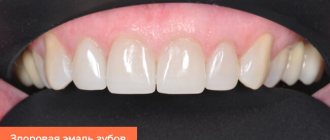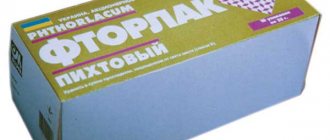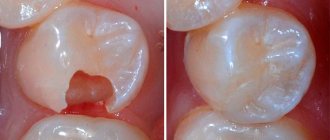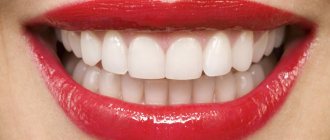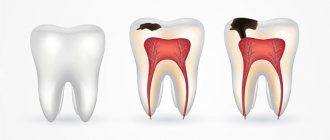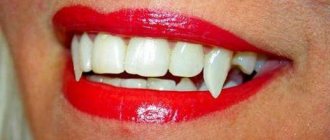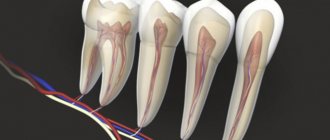Most dental diseases begin with damage and destruction of the enamel. At this stage, it is important to provide timely dental care and take a number of measures to restore the protective layer. But, if everything is familiar and understandable with dental treatment, then how to restore enamel if the destructive process has already begun? Is there a chance to save my teeth? "Medical Expert" suggests looking into this issue.
Causes of destruction of the enamel layer of teeth
Enamel is a mineral layer about 2 mm thick that covers the crown of the teeth.
97% consists of a crystalline substance of hydroxyapatite with small inclusions of calcium, fluorine, magnesium, and carbon. Performs a protective function, protects dentin and pulp from external influences. This is the hardest tissue in the human body; 1 square millimeter of its area can support 397.6 kg. But, nevertheless, even such a durable material can begin to deteriorate due to exposure to physical or chemical factors. The most common causes of enamel destruction:
- accumulation of plaque due to poor hygiene;
- exposure to concentrated acids contained in natural juices and carbonated drinks;
- unbalanced diet, large amounts of carbohydrates in the daily diet;
- mechanical injuries to the tooth crown with the formation of cracks and chips;
- bad habits of chewing pens and pencils;
- bite defects;
- wearing braces;
- abnormal abrasion of the enamel layer;
- bruxism (uncontrolled teeth grinding);
- sudden changes in temperature (for example, hot coffee after ice cream);
- diseases accompanied by leaching of calcium from the body (diabetes mellitus and other pathologies of the endocrine system);
- hereditary factor;
- stomach diseases in which the absorption of calcium and phosphorus is impaired;
- metabolic destabilization;
- caries;
- periodontal diseases;
- age-related tissue nutritional disorders.
Folk remedies
- Mix of garlic and beet juice.
- Rinse with soda solution.
- Brushing teeth with wood ash or crushed activated carbon.
- Using the inside of a lemon peel to wipe and treat enamel (there is an aggressive effect on the enamel).
- Propolis extract solution - you need to rinse your teeth regularly, morning and evening, without missing the effect. To enhance the effect, calamus extract is added.
- Rinse with sea salt.
You can use herbal decoctions to strengthen the enamel and improve its color.
Benefits of using traditional medicine:
- No side effects;
- Available components;
- Low cost.
If the enamel is clearly damaged, it is impossible to correct the situation on your own. It is recommended to consult a doctor for professional restoration.
How to determine when it’s time to restore enamel
In order to preserve the integrity of the enamel layer as much as possible (or at least stop its destruction), it is very important not to miss the first signs of the pathological process. Its initial stages are characterized by demineralization of a local area of the tooth surface. It looks like a white, non-glossy spot. This clinical picture is called caries in the white spot stage. Another sign is the appearance of tooth sensitivity. Normally, a person does not feel the touch of the tongue on the teeth, there are no unpleasant sensations when chewing food. There is also no reaction when the teeth come into contact with cold, hot, sweet or sour foods. If any of the listed signs appear in the patient, this means that the enamel layer of his teeth has begun to gradually deteriorate. The following stages of enamel corrosion are visible to the naked eye. A local dark area forms on the surface of the tooth, then it begins to expand in area and go deeper into the dentin. These are signs of a serious defect. Correcting it will require more complex measures than when the first symptoms appear.
Important: a person cannot always independently see the stage of a white spot or a small black spot. Therefore, it is extremely important to visit your dentist for a checkup twice a year. Specialists from our network of clinics will be able to promptly detect an emerging defect and eliminate the damage with minimal intervention in the tooth structure (or without it at all). Our branches are equipped with modern equipment and instruments, including dental microscopes for diagnosis and treatment.
Clinical researches
Clinical studies have proven that regular use of professional toothpaste ASEPTA REMINERALIZATION improved the condition of the enamel by 64% and reduced tooth sensitivity by 66% after just 4 weeks.
Sources:
- Report on the determination/confirmation of the preventive properties of personal oral hygiene products “ASEPTA PLUS” Remineralization doctor-researcher A.A. Leontyev, head Department of Preventive Dentistry, Doctor of Medical Sciences, Professor S.B. Ulitovsky First St. Petersburg State Medical University named after. acad. I.P. Pavlova, Department of Preventive Dentistry
- Report on determining/confirming the preventive properties of commercially produced personal oral hygiene products: Asepta toothpaste used in combination with Asepta mouthwash and Asepta gum balm Head. Department of PFS Doctor of Medical Sciences Professor S.B. Ulitovsky St. Petersburg State Medical University named after Academician I.P. Pavlova. Faculty of Dentistry. Department of Preventive Dentistry.
- Clinical and laboratory assessment of the influence of domestic therapeutic and prophylactic toothpaste based on plant extracts on the condition of the oral cavity in patients with simple marginal gingivitis. Doctor of Medical Sciences, Professor Elovikova T.M.1, Candidate of Chemical Sciences, Associate Professor Ermishina E.Yu. 2, Doctor of Technical Sciences Associate Professor Belokonova N.A. 2 Department of Therapeutic Dentistry USMU1, Department of General Chemistry USMU2
Restoration methods for the initial stage of destruction
Restoration of tooth enamel is the implementation of measures aimed at reconstructing the appearance of the enamel layer and restoring the protective functions it performs.
It is performed using various methods depending on the condition of the enamel. The earlier measures are taken, the better the effect. When initial symptoms appear, the following measures are effective:
- professional hardware teeth cleaning;
- remineralization – saturation of enamel with essential minerals, including fluoridation (coating teeth with a special varnish).
Note: it is impossible to restore enamel at home. The patient can only help the doctor. To do this, he must review his diet, carefully carry out hygienic dental care, eradicate bad habits, and begin treating systemic diseases (if any).
Restoring tooth enamel at home
Folk remedies used to restore enamel can strengthen tooth enamel, which is primarily useful as a preventive measure and is applicable for minor damage. Products containing fluoride are always marked “therapeutic” or “therapeutic and prophylactic”. These include tooth powders, pastes, gels, and mouth rinses. In addition to fluoride salts, medicinal toothpastes contain tin fluoride, sodium fluoride and other organic compounds. Modern toothpastes contain the substance triclosan, which helps increase the effect of beneficial fluoride and other compounds directly between brushing your teeth. Triclosan slows down the formation of tartar.
- The use of medicated toothpastes containing fluoride is effective, but does not last long. When brushing your teeth, it is recommended to leave the composition for a while for greater effect. Fluoride ions actively fight bacteria that cause caries.
- Toothpastes with minerals also effectively strengthen tooth enamel and, in addition to regular brushing, are recommended to be rubbed into the surface of the tooth.
- Massaging the gums and directly strengthening the gums themselves by rinsing with herbal decoctions or special rinses will strengthen your teeth. Massaging your gums helps improve blood circulation, but you should do it carefully to prevent injury to your gums. The most useful for rinsing is a rinse based on oak bark.
- Fluoride-containing gels are available in spray form, but you should consult your dentist before using them.
- Chewing gum after eating promotes the secretion of saliva, which means better cleaning of teeth.
- Diet is the basis of dental health
The following products must certainly be present in a person’s diet: - dairy products, such as cheeses, cottage cheese, kefir, milk. They contain calcium, which is necessary to strengthen tooth enamel. — vegetables and fruits are best consumed raw, as this is an additional natural cleansing of the teeth. It is better to eat solid foods such as apples and carrots.
You should be careful with folk remedies for restoring damaged tooth enamel so as not to worsen the situation.
More information about folk methods of strengthening enamel:
- For example, using lemon zest, which is rubbed into damaged areas. The result lasts for a week and it depends on the degree of damage to the enamel.
- Baking soda can be added to toothpaste, but, nevertheless, this method often harms the enamel. It is better to do this no more than once a week.
- Berries, for example, garden strawberries, cope well with minor damage.
- Hydrogen peroxide is an effective but dangerous method. Rinse the mouth with the solution or wipe the surface of the teeth.
- You can use activated carbon; to do this, dissolve one or two tablets in water, and then rub the resulting mass or brush your teeth with it, but not more than once every 3 days.
- Cow's milk can serve as a mouthwash.
Restoration methods for serious enamel defects
In cases where the enamel layer has undergone significant destruction, a set of measures consisting of two stages is indicated, the first of which is dental treatment of the damaged tooth. Only then will the dentist begin the actual restoration. This could be the application of artificial enamel, composite restoration or dentures. The methods listed above help stop decay, restore the appearance, and protect the inner layers of the tooth.
Relatively small defects can be eliminated by applying artificial enamel or composite reconstruction (the doctor uses special materials to recreate the shape of the tooth). More serious problems of the enamel layer are solved by installing microprostheses (veneers or lumineers). These are the thinnest pads that the orthopedist fixes to the vestibular surface. If the dental element is destroyed to a significant extent, then the doctor forms a stump and installs a crown on it.
Note: the choice of restoration option for the enamel layer is made by the dentist after diagnostics and identification of the extent of the damage.
Classification of disease prevalence
With local abrasion, only individual teeth are affected - as a rule, against the background of some acquired factors; with generalized abrasion, this problem already affects the entire dentition, and such an anomaly is usually congenital.
Symptoms of increased tooth wear
- the appearance of tooth enamel changes, it becomes uneven, rough, and tubercles appear on it;
- the natural color of the teeth changes, they become almost translucent;
- teeth acquire increased sensitivity to the effects of cold and heat, to mechanical or chemical irritants;
- sharp edges form on the enamel, which can injure the mucous membrane on the inner surface of the lips and cheeks;
- the teeth are shortened, the lower third of the face decreases in size, and folds appear in the corners of the mouth;
- hearing loss occurs and the chewing process is disrupted.
Prevention measures
- Careful hygiene at home - at least twice a day, every day
- Clinic visits for professional cleaning – once or twice a year
- Eating foods high in vitamins and minerals
- Reducing intake of high carbohydrate foods
- Avoiding carbonated sugary drinks
- Timely treatment of dental and periodontal diseases
The network of dental clinics “Smile” offers services for restoring tooth enamel. Contacting our specialists has a number of undeniable advantages:
- treatment by highly qualified doctors;
- compliance with treatment protocols that meet international standards;
- family and savings discounts;
- transparent pricing;
- Convenient work schedule: daily until 21:00 (Sunday until 16:00).
You can make an appointment at any of the branches of our clinic in Moscow, located within walking distance from metro stations:
- Art. Alekseevskaya (VDNKh district, etc. Mira), address: st. 3rd Mytishchiskaya house 3, building 2;
- Art. Shelepikha, address: Shelepikhinskaya embankment, address: building 34, building 1.
The high qualifications of our specialists and modern equipment allow us to solve the problem of restoring enamel at any stage of destruction. We guarantee the effectiveness of treatment and the safety of the methods used. Your health is in good hands!
Reviews
We invite readers who have experience in using enamel restoration methods to share their feedback in the comments to the article.
If you find an error, please select a piece of text and press Ctrl+Enter.
Tags tooth enamel
Did you like the article? stay tuned
Previous article
Teeth are crumbling, what to do in such a situation?
Next article
Oral irrigator Waterpik WP-100 E2 Ultra: what it is, advantages, approximate cost
